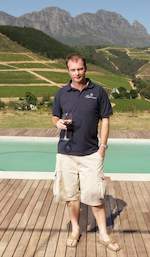A 30-hectare property, Woodlands has shale soils typical of the hillsides on the False Bay side of the Simonsberg, promising wines with structure and a marked minerality. Serendipitously, it turned out to have been owned by old Finlayson family friends, the Micklems, who'd farmed flowers and fruit (including berries of all kinds) from the 1950s, David Finlayson had visited here as a boy.

By some coincidence, the property's original title deeds listed the farm's name as Edgebaston. It also happened to be the name of the town near Birmingham in the UK that was the home of David's maternal grandfather Gordon Egerton. Thus was born the new Edgebaston Finlayson Family Vineyards wine label. The thistle as its logo acknowledged David's Scottish heritage on his paternal side (as does the good Scots name of his young son Callum).
David and Walter spent the next three years establishing some 24 hectares to mainly classic standards cabernet sauvignon, shiraz, chardonnay, and sauvignon blanc. David debuted in 2007 to instant acclaim with three of them: The Edgebaston Chardonnay, Shiraz, and the 'GS' Cabernet Sauvignon. Together with Platter's South African Wines Guide five-star rating and Wine Spectator (USA) top score, the 'GS' came with a fascinating story.
'GS' stands for George Spies, an art teacher who became a respected winemaker in the 1960s. Known particularly for his sherries and ports produced by former Monis of Paarl and Stellenbosch Farmers' Winery, he is thought to have made and bottled a couple of vintages of wine simply labeled GS Cabernet. Little is known of its provenance; discussion and details are shrouded in mystery and intrigue. Yet wine men who have found and tasted the rarefied 1966 have raved about it.
This includes David. He recalls seeing a bottle of it in a cupboard at home as a boy, eventually tasting it as a budding winemaker with his father and their UK wine agent. All were amazed. Setting himself the goal of recreating a wine of similar quality and longevity, David decided to reintroduce the name with his Edgebaston 'GS' Cabernet Sauvignon, which piqued interest once more.
A subsequent select tasting of another miraculously sourced '66, as well as a '68, the only other known vintage of the wine, and a '66 Château Haut-Brion as a comparable international benchmark, elicited a similar response. One veteran Wine Spectator senior editor scored it an almost unprecedented 95, pronouncing it 'the one true classic' of Cape wine he'd ever tasted.
But this is now and this is Edgebaston. and David, though respectful of history, is focussed on the future. Dictated by terroir, his property's plantings also reflect the young vintner's areas of expertise in specific single-varietal wines as well as his innovative bent.
There are soupçons of precious pinot noir and trendy mourvèdre. There is the Cape’s rarely planted through recognised red varieties zinfandel, petite Sirah, and tannat (a variety from southwest France known for its structure, long life, and raspberry perfume). There is some sémillon and viognier. He also sources special parcels of grapes that echo the Edgebaston character.
These blends are being bottled under quirky labels, serendipitously designed by Spies’ daughter who is a graphic designer. The names evoke the farm's heritage and the wines' varietal characters.
The Pepper Pot combines spicy shiraz and mourvèdre with viognier and tannat, as well as grenache and cinsaut. The Berry Box is a mélange of six red grapes (including Bordeaux classics most typically redolent of all the different kinds of bush berries). The Berry Box White is just an off-dry pale gold blend of sémillon, sauvignon blanc, and viognier.
 Herbed ostrich fillet recipe by David Finlayson paired with Edgebaston Cabernet Sauvignon....
Herbed ostrich fillet recipe by David Finlayson paired with Edgebaston Cabernet Sauvignon.... Tuna carpaccio recipe by Drainbow peppercornsavid Finlayson paired with Edgebaston Chardonnay....
Tuna carpaccio recipe by Drainbow peppercornsavid Finlayson paired with Edgebaston Chardonnay....